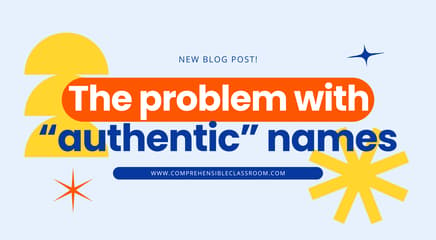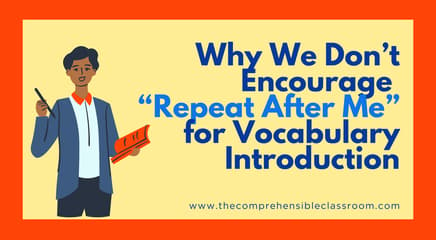Over the last decade, I have come to realize that I entered the profession of language education with a lot of beliefs about language and language teaching, but those beliefs were based on impressions that I had from my own personal experience, not on facts. I began learning about language when I began learning about Teaching Proficiency through Reading and Storytelling (TPRS®), and it has been so motivating to learn about the nature of language and what we know about how language is acquired.
The Motivated Classroom: Episode 50
This afternoon, I listened to Episode 50 of The Motivated Classroom (TMC) Podcast. Dr. Liam Printer launched TMC just over a year ago, and the special extra-long 50th episode was the recording of a conversation that Dr. Printer had with Dr. Bill VanPatten and Dr. Karen Lichtman during the CI Reboot conference, which was hosted by Fluency Fast. In this episode, Drs. Lichtman and VanPatten discuss their peer reviewed publication on 40 years of Second Language Acquisition research. Hearing this conversation again was motivating, and it helped me to see some big ideas about language in a new way.
This is an episode worth making time to listen to, and I want to share some of the ideas that really stood out to me.
The role of CI is a fact.
Beginning at about minute 9, Dr. VanPatten discusses the difference between a theory and a fact. He states that role that comprehensible input (CI) plays in language acquisition is often misconstrued as being a theory.
That comprehensible input plays a fundamental role in language acquisition is not a theory that must be proven; it is a fact that needed/needs to be explained. That there is a distinction between language acquisition (implicit knowledge) and language learning (explicit knowledge) is not a theory, it is a fact. That language acquisition is ordered and happens in stages (ordered development) is not a theory, it is a fact. These three components of the Input Hypotheses are observable facts about language acquisition (a) that people should know and (b) that theories have to explain.

As I was reflecting on this, I realized that one problem in thinking of the role of CI as a belief, and not a fact, is that it would imply that another belief might be equally valid. It creates space for disagreements within departments in which some teachers believe that comprehensible input plays one role and others believe that it plays a different role. Yet, the fact is that the role of CI in language acquisition is not up for debate!
As our Director of Training Elicia Cárdenas said in a recent Fun Club episode, "Teachers deserve to teach in a way that is effective and meaningful" (adapted from Angela Watson). If you find yourself wondering whether your move toward comprehension-based teaching was the right choice, remember: comprehensible input plays a fundamental role in language acquisition. FACT! There is an order in which humans acquire language, and explicit instruction cannot supersede the order of acquisition because explicit learning and implicit learning are distinct processes. FACT! Be confident that if you are teaching with a focus on providing your students with communicatively embedded input that they understand, you are on a sound path.
Does grammar instruction help?
About a quarter of the way into the episode (minute 16), Dr. Printer asked, "Is it true that learners who receive grammar instruction "do better" [with language learning] than those that don't?". I was so glad that they tackled this question, because rethinking grammar teaching and letting go of grammar teaching has been a pain point for me.
The big idea to grasp here is the distinction between explicit and implicit learning. There is a qualitative difference between explicit and implicit knowledge, and no research has uncovered a mechanism that can convert explicit information into implicit knowledge. Dr. VanPatten said, "We teach grammar because we think it is becoming language in our heads, but it's not". Dr. Lichtman said it in another way; that grammar is not language. Language is language, and grammar serves as a monitor to edit my language–the language I have acquired–as it comes out of my head. She said, "Grammar is not my language, it is me editing myself".
Explicit knowledge doesn't become implicit knowledge
But... why does it matter that, as far as we know, explicit knowledge cannot be converted into implicit knowledge? Why does it matter that these two things are distinct? At minute 20:00, Dr. VanPatten shared an analogy that really resonated with me. It is as though explicit knowledge is water and implicit knowledge is olive oil. The molecular structure of water is incredibly simple: H2O, baby! The molecular structure of olive oil is not.
Like a molecule of olive oil, the language that ends up in our heads is incredibly complex. If we take in water (explicit instruction), there is no way that we can turn it into olive oil (implicit knowledge). There is no way to turn a water molecule into an olive oil molecule under known science. For that to happen, we would need a mechanism... and no mechanism has ever been identified. Likewise, no mechanism has ever been identified that can turn explicit information into implicit knowledge in our heads.

Implicit learning brings lasting results
Dr. Lichtman concludes that we should aim to minimize explicit instruction because developing the implicit knowledge is so important and takes so much time. We need to focus our class time on that. She offered a second analogy; that explicit learning is like steroids, and implicit learning is like training. Steroids can give you a boost in performance, but the boost is temporary. Training produces long-term, lasting results. Much like athletes that take steroids can trick the fan into believing that the athlete is capable of something, on their own power, that they are not– so grammar instruction can trick us and give us a false view of what students are capable of. Linguistic competency developed as a result of explicit instruction tricks us into thinking that students have language in their heads that they don't. It is only training–implicit instruction–that produces lasting results.

You can spend time on explicit learning in the last week of the school year and see the same benefits as if you had focused on explicit learning all year. If you are going to do grammar, Dr. VanPatten suggests, "do less of it and do it later". Grammar instruction should not be a foundational component of language courses.
Why is it so hard to let go of explicit instruction?
I loved that the trio dug into this question. Dr. Printer wondered, are language teachers hesitant to let go of explicit instruction due to their deeply held beliefs about language acquisition, or is it something else?
The consensus appeared to be, "Yes, and...". It is true that we have a hard time letting go of explicit instruction due to our deeply held beliefs about language acquisition; but often we don't even know what our beliefs are. In fact, this was the topic of one of our most recent Fun Club episodes!:
Beyond the fact that we may have a hard time identifying and releasing our foundational beliefs, there are practical reasons for which it is hard to let them go. The institution of language education provides resources and a path for explicit learning, not implicit learning. Changing our beliefs means having to figure out what to do in class without the help of a textbook for planning. It means rethinking how to give your students a grade (side note, if this is where you're at– join us for Assessment for Acquisition Boot Camp in September!). Dr. VanPatten pointed out that there is a domino effect of things that teachers need to do and problems they need to solve if you decide to move away from explicit instruction. When teachers are already working at their limits, taking on this extra burden is just too much.
What is language?
"What we need is for teachers to stop believing what they think is language is language", Dr. VanPatten stated. Language is the most understudied and least understood thing among teachers. Typically in the US we get a degree in education combined with a major in language and we never learn about the nature of language. I know that this is true for me! I majored in Spanish with a certification in Adolescent Education. The ONLY course that was directly related to language teaching was my methods course, and I never took a course about language itself. Dr. VanPatten observed that language teachers get a warped perspective of what language is because we are never asked to really consider it. We form beliefs based on what we experience, so we end up thinking that language in our heads looks like the language we see in textbooks, which is stored in lists and governed by rules–but it is not!
We may also confuse language with communication, and at about 38 minutes Dr. Lichtman shared an anecdote to help me understand this point. She talked about her 21 month old daughter's language learning journey, and how she added new words very slowly up until 20 months. Then, from 20 to 21 months, her language exploded! She said so many words for the first time.
The fact of the matter is, her daughter did not "learn so many new words" or "add so many new words to her language" only between 20 and 21 months. She added new words to her productive mode of communication- but language is not communication. Invisible to the human eye, her daughter was building up language in her head all of that time that Dr. Lichtman was worrying about why she wasn't saying more words. Language and communication are not the same thing, and this anecdote helped me to see that as much as I know and believe this, I still do not understand all of its implications. Language is not communication; it is observed through communication.
What about interaction?
My methods teacher placed a heavy emphasis on interaction, as did the district coordinator at my teaching job in Anchorage. Before I began learning about language acquisition and comprehension-based teaching, my goal was to get students talking with each other so that they could learn language.
I have since come to believe, based on facts about language acquisition, that students do not acquire language through output; they don't acquire language by talking. INPUT drives language acquisition. Knowing this, what if anything does interaction have to do with language acquisition? Dr. Printer asks, "What does the research tell us about the role of interaction in the role of developing acquisition?"
In sum, beginning at about minute 40, Dr. VanPatten summarizes its role as, "Overstated and overblown. The effects are very limited". Then, he cited the late Michael Long and said something that felt like a real light bulb moment to me: "What interaction gets you is more comprehensible input. It gets you modified language that you can use as a language learner". I have expressed this concept before; the idea that output drives input; but I had never thought about the specific KIND of input that interaction can bring to a learner.
What is interaction?
Much like I have had to reframe my thinking about what communication is (I used to use communication as a synonym for talking and writing, completely ignoring the interpretive mode), Dr. VanPatten helped me in this episode to reframe my thinking on what interaction is. If I am being honest in examining my beliefs, I have always thought of interaction as a synonym for the interpersonal mode (two people chatting back and forth), but never really thought about it at a deeper level.
Dr. VanPatten framed interaction as the answer to a question: "How is that you participate in conversations?" Interaction doesn't have to be two people engaging at a similar level in a conversation. Just like communication isn't just production, interaction isn't just production. Interaction evolves naturally over time, and it begins with learners being dependent on the other party in their communication. It begins with learners engaging heavily in the interpretive mode!
This connects to the goals, or the outcomes, that we establish for our language programs, and it makes an extraordinary amount of sense to me. Dr VanPatten said:
Development of communication over time should look like a move from complete dependence on the interlocutor to independence from the interlocutor. It is moving from a point where you are dependent on their discourse to where you can move the discourse along on your own.
Doesn't this make so much sense?? The ultimate goal of a language program isn't "get students to speak the language" or "get them to speak the language better", it is helping them to move toward independent discourse. MIC DROP!

What are we trying to teach?
Even as we come to believe that what our heads is not what is in textbooks, we still (at least I still!) believe that we are teaching something... but what? Toward the end of this episode, Drs. Lichtman and VanPatten challenge listeners to rethink the idea that we are trying to teach anything.
They affirm: "Communicatively embedded input is not about teaching rules or vocabulary or teaching anything; it's about communicating. We aren't teaching anything through input!". As we provide our students with input, the learner takes bits and pieces of data from that input, processes it, and builds language in their heads. As a teacher, we have no idea what those bits and pieces are.
Is there a place for pop-up grammar?
Pop-up grammar refers to an approach to explicit instruction that is often used in comprehension-based courses. Similar to a "noticing" approach to grammar instruction, the teacher gives quick explanations (like 10 seconds or less) about the linguistic features that students can observe in a chunk of input. For example, the teacher might make a statement like, "He walked to school", and then say, "See that -ed at the end of the verb? That means that it happened in the past".
Dr. Lichtman says that yes, there is a place for pop-up grammar because it is comprehension-based. Then, she explained that statement in a way that I had never heard before. She said that what she means by pop-up grammar being comprehension-based is that pop-up grammar is taking the meaning and helping the learner to map it correctly onto meaning in their brain. You are helping students to get the meaning of what they are interpreting right. Dr. VanPatten did caution that even still, we must remember that the meaning that we are helping students to get right is a surface-level meaning, not the whole meaning.

In closing
All of these ideas point to one central action item, which Dr. VanPatten states toward the end of the conversation: "We [language teachers] tend to work with beliefs, not facts. Examine your assumptions and move from belief-based teaching to fact-based teaching."
Get motivated!
If you, like me, found this conversation to be motivating, I encourage you to connect with Dr. Liam Printer and follow his podcast.

The Motivated Classroom
- Subscribe to The Motivated Classroom podcast wherever you listen to podcasts!
- Follow @motclasspodcast on Twitter
- Follow @themotivatedclassroom on Instagram
- Join the conversation with the hashtag #MotivatedClassroom.
Key talking points, research and references (taken from Episode 50 programme notes):
- Norris, J. M. & Ortega, L. (2000). Effectiveness of L2 instruction: A research synthesis and quantitative meta-analysis. Language Learning, 50, 417-528.
- Piggott et al. (2000). The icing on the cake? Effects of explicit form-focused instruction after two years of implicit EFL learning
- Spada, N. & Tomita, Y. (2010). Interactions between type of instruction and type of language feature: A meta-analysis. Language Learning, 60, 263-308.
- Lichtman, K. & VanPatten, B. (2021). Was Krashen right? Forty years later. Foreign Language Annals, 54, 283-305.
- Lichtman, K. & VanPatten, B. (2021). Krashen forty years later: Final comments. Foreign Language Annals, 54, 336-340.
- VanPatten, B., Smith, M. & Benati, A. (2020). Key questions in second language acquisition. Cambridge: Cambridge University Press.




